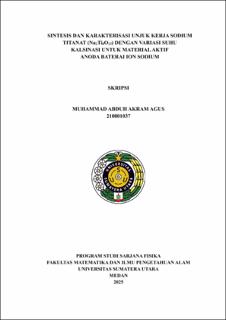| dc.description.abstract | In this study, the synthesis and performance characterization of Sodium Titanate (Na₂Ti₆O₁₃) were carried out to evaluate its potential as an anode material for sodium-ion batteries, with particular emphasis on the effect of calcination temperatures at 900°C, 950°C and 1000°C. The material was synthesized using a template-assisted hydrothermal method employing NaCl, citric acid, TTIP (Titanium(IV) isopropoxide) and ethylene glycol as precursors. The hydrothermal process was conducted at 150°C for 6 hours, followed by calcination at the specified temperatures for 3 hours. Characterizations were performed using X-Ray Diffraction (XRD) to determine crystal structure, Scanning Electron Microscopy coupled with Energy Dispersive Spectroscopy (SEM-EDS) for morphological and elemental analysis, and Brunauer–Emmett–Teller (BET) analysis to assess surface area and porosity. The electrochemical performance was evaluated through Cyclic Voltammetry (CV) in a half-cell configuration (Na2Ti6O13||Na) using 1 M NaClO₄ in an EC:DEC (1:1) electrolyte solution. XRD results confirmed the successful formation of Na₂Ti₆O₁₃ as the dominant phase with a monoclinic crystal structure (C2/m) across all samples. SEM analysis revealed that the most uniform and well-defined rod-like morphology was achieved at a calcination temperature of 950°C. BET analysis indicated that the NTO-950 sample possessed the highest specific surface area, measuring 3.707 m²/g. CV measurements demonstrated that NTO-950 exhibited the highest peak current and the largest pseudocapacitive contribution, indicating superior redox stability. In contrast, NTO-900 showed lower current response, while NTO-1000 suffered performance degradation due to excessive sintering. Therefore, calcination at 950°C is identified as the optimal condition for synthesizing sodium titanate with enhanced crystallinity, favorable morphology, and superior electrochemical properties as an anode material for sodium-ion batteries. | en_US |


